
eBook - ePub
Introducing Modernism
A Graphic Guide
Chris Rodrigues,Chris Garratt
This is a test
Condividi libro
- 176 pagine
- English
- ePUB (disponibile sull'app)
- Disponibile su iOS e Android
eBook - ePub
Introducing Modernism
A Graphic Guide
Chris Rodrigues,Chris Garratt
Dettagli del libro
Anteprima del libro
Indice dei contenuti
Citazioni
Informazioni sul libro
Modernism is usually thought of as a shock wave of innovations hitting art, architecture, music, cinema and literature - the work of Picasso, Joyce, Schoenberg, movements like Futurism and Dada, the architecture of Le Corbusier, T.S. Eliot's The Wasteland and the avant-garde theatre of Bertolt Brecht or Samuel Beckett. But what really defines modernism? Why did it begin and how long did it last? Is Modernism over now? Chris Rodriguez and Chris Garratt's brilliant graphic guide is a brilliant exploration of the last century's most thrilling artistic work - and what it's really all about.
Domande frequenti
Come faccio ad annullare l'abbonamento?
È semplicissimo: basta accedere alla sezione Account nelle Impostazioni e cliccare su "Annulla abbonamento". Dopo la cancellazione, l'abbonamento rimarrà attivo per il periodo rimanente già pagato. Per maggiori informazioni, clicca qui
È possibile scaricare libri? Se sì, come?
Al momento è possibile scaricare tramite l'app tutti i nostri libri ePub mobile-friendly. Anche la maggior parte dei nostri PDF è scaricabile e stiamo lavorando per rendere disponibile quanto prima il download di tutti gli altri file. Per maggiori informazioni, clicca qui
Che differenza c'è tra i piani?
Entrambi i piani ti danno accesso illimitato alla libreria e a tutte le funzionalità di Perlego. Le uniche differenze sono il prezzo e il periodo di abbonamento: con il piano annuale risparmierai circa il 30% rispetto a 12 rate con quello mensile.
Cos'è Perlego?
Perlego è un servizio di abbonamento a testi accademici, che ti permette di accedere a un'intera libreria online a un prezzo inferiore rispetto a quello che pagheresti per acquistare un singolo libro al mese. Con oltre 1 milione di testi suddivisi in più di 1.000 categorie, troverai sicuramente ciò che fa per te! Per maggiori informazioni, clicca qui.
Perlego supporta la sintesi vocale?
Cerca l'icona Sintesi vocale nel prossimo libro che leggerai per verificare se è possibile riprodurre l'audio. Questo strumento permette di leggere il testo a voce alta, evidenziandolo man mano che la lettura procede. Puoi aumentare o diminuire la velocità della sintesi vocale, oppure sospendere la riproduzione. Per maggiori informazioni, clicca qui.
Introducing Modernism è disponibile online in formato PDF/ePub?
Sì, puoi accedere a Introducing Modernism di Chris Rodrigues,Chris Garratt in formato PDF e/o ePub, così come ad altri libri molto apprezzati nelle sezioni relative a Art e Histoire de l'art moderne. Scopri oltre 1 milione di libri disponibili nel nostro catalogo.
Informazioni
Argomento
ArtCategoria
Histoire de l'art moderneRealizing Modernism
This book will try to answer 15 basic questions on modernism, and is specifically concerned with modernism in the arts.
1. What is modernism?
2. When does modernism begin?
3. What is the difference between modernism and “modernity”?
4. Is modernism just a reaction to modernity?
5. How do we recognize a “modernist” work?
6. Is there a modernist theory in relation to practice?
7. What is the relation of modernism to primitivism?
8. What is the relation of modernism to psychoanalysis?
9. What is the role of the city in modernism?
10. Why are modernists so often “exiles”?
11. What is the role of élites and avant-gardes in modernism?
12. What politics did modernists espouse?
13. How does modernism relate to mass culture?
14. What is the relation of cinema to modernism?
15. Has modernism ended?

THE LAST QUESTION IS A RETURN TO THE FIRST WITH (WE HOPE) A SATISFYING ANSWER TO IT. YOU MIGHT SEE THESE QUESTIONS AS CHAPTERS IN A DETECTIVE NOVEL ...
What is Modernism?
What is the first feature of modernism that is generally acknowledged? Most of us will agree that a modernist work is perceived as difficult, and that its difficulty is associated with unfamiliarity and difference. D.H. Lawrence (1885–1930), who might himself be classified a modernist writer, expressed this feeling of the pleasure and pain of difficulty.
“… to read a really new novel will always hurt, to some extent. There will always be resistance. The same with new pictures, new music. You may judge of their reality by the fact that they do arouse a certain resistance, and compel, at length, a certain acquiescence.”
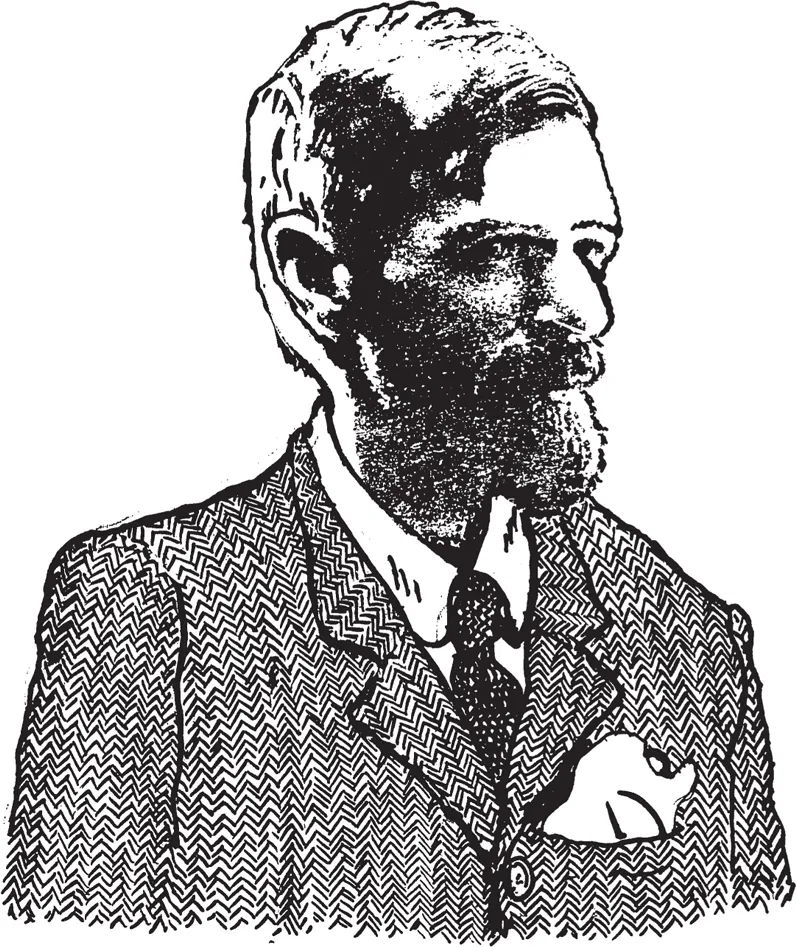
All works that can be accommodated under the umbrella of modernism – or, as we’ll see, schools of modernisms – share a relationship to the modern world which is peculiarly new and exceptional to any other previous cultural and historical condition.
Novelty and difficulty form a special historical alliance. That’s one feature. Another is the reply that most people will give to the question: “What is modernism?” More than likely, they will identify it by naming its icons.

PABLO PICASSO (1881–1973), SALVADOR DALÍ (1904–89), T.S. ELIOT (1888–1965), ARNOLD SCHOENBERG (1874–1951), LE CORBUSIER (1887–1965), KASIMIR MALEVICH (1878–1935).
... EZRA POUND (1885–1972), FRANK LLOYD WRIGHT (1867–1959), MARCEL PROUST (1871–1992), VIRGINIA WOOLF (1882–1941), IGOR STRAVINSKY (1882–1971), RAINER MARIA RILKE (1875–1926) ...
MAN RAY (1890–1976), THOMAS MANN (1875–1955), LEON TROTSKY (1879–1940), ALBAN BERG (1885–1935) ...... ... SHALL WE GO ON?
... EZRA POUND (1885–1972), FRANK LLOYD WRIGHT (1867–1959), MARCEL PROUST (1871–1992), VIRGINIA WOOLF (1882–1941), IGOR STRAVINSKY (1882–1971), RAINER MARIA RILKE (1875–1926) ...
MAN RAY (1890–1976), THOMAS MANN (1875–1955), LEON TROTSKY (1879–1940), ALBAN BERG (1885–1935) ...... ... SHALL WE GO ON?
Interesting reasons can be found – positive and negative – why these names occur. Let’s consider just three from this list.
Media High Profile
What makes an icon? Picasso is likely to be remembered not just because he was a “great artist”. Media notoriety is crucial.
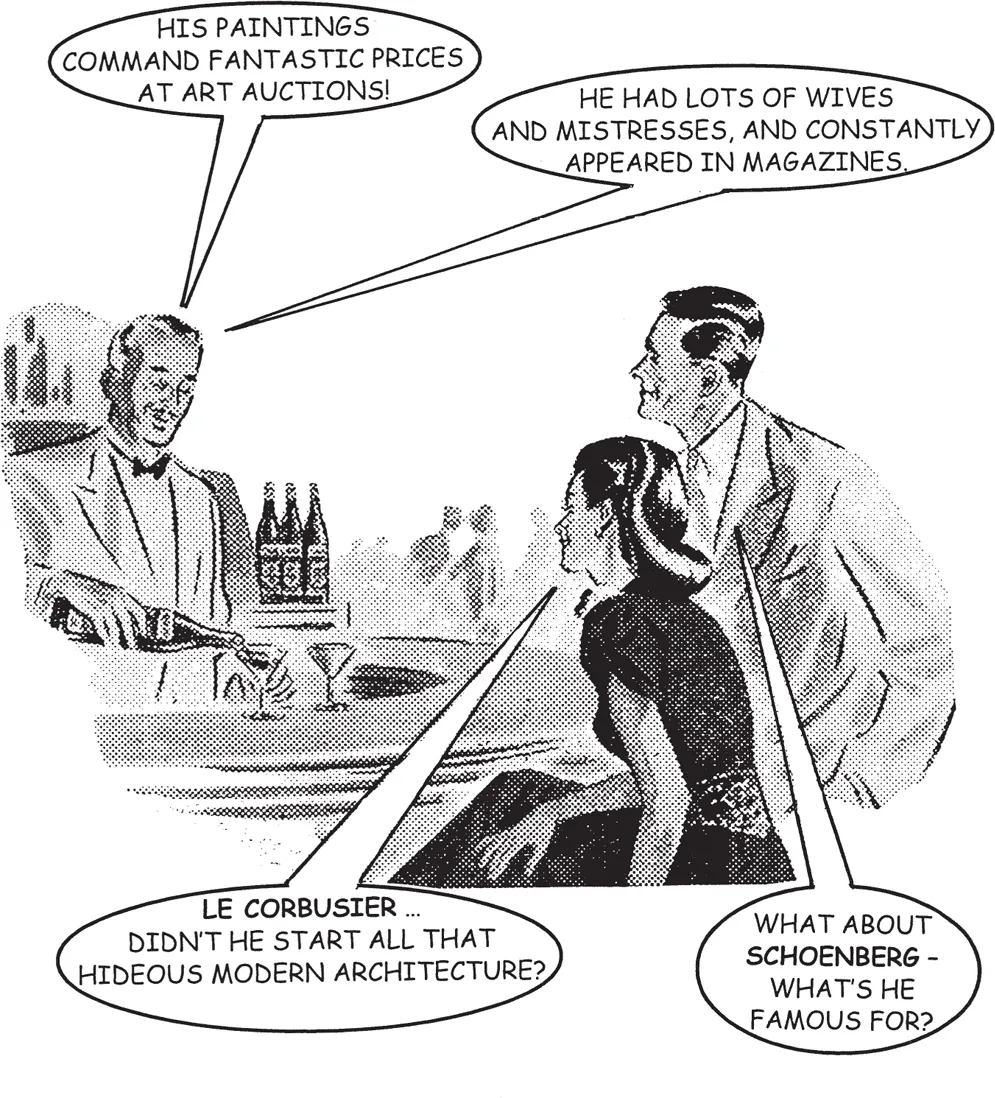
HIS PAINTINGS COMMAND FANTASTIC PRICES AT ART AUCTIONS!
HE HAD LOTS OF WIVES AND MISTRESSES, AND CONSTANTLY APPEARED IN MAGAZINES.
LE CORBUSIER ... DIDN’T HE START ALL THAT HIDEOUS MODERN ARCHITECTURE?
WHAT ABOUT SCHOENBERG – WHAT’S HE FAMOUS FOR?
HE HAD LOTS OF WIVES AND MISTRESSES, AND CONSTANTLY APPEARED IN MAGAZINES.
LE CORBUSIER ... DIDN’T HE START ALL THAT HIDEOUS MODERN ARCHITECTURE?
WHAT ABOUT SCHOENBERG – WHAT’S HE FAMOUS FOR?
Arnold Schoenberg might not figure so high in the media stakes. His brand of (“classical”?) modernist music is, of all the modernisms, the most élitist and remote from the feelings of contemporary society. What does the “a-tonal” style or the “serial” system of composition mean to us? Most of us are happier with less cerebral forms of music that we can still identify as modern.

JAZZ – THAT’S REALLY MODERN!
YES, BUT SO WAS THE TANGO CRAZE OF THE 1920S ...
YES, BUT SO WAS THE TANGO CRAZE OF THE 1920S ...
Keeping up with Fashion
Fashion has the benefit of making us reflect on what modernism isn’t, what it was reacting against, what it intended to replace.

WHAT’S WRONG WITH VICTORIAN VALUES? THE VIRTUES OF COMFORT, SENTIMENT, ESTABLISHED RULES ...
YOU’RE STUFFY, UNSEXY ... UNMODERN!
TRY READING EZRA POUND – VITAMIN C FOR THE SOUL, THAT’S WHAT YOU NEED!
YOU’RE STUFFY, UNSEXY ... UNMODERN!
TRY READING EZRA POUND – VITAMIN C FOR THE SOUL, THAT’S WHAT YOU NEED!
And this might lead us to think of trends or movements characteristic of modernism – for instance, Cubism, Dadaism or Surrealism – instead of simply naming personalities.
Such isms – indeed modernism itself – provide clues to the “spirit of the age’’, the Zeitgeist as it’s often called. Modernism expresses the new energies sweeping through from the late 19th century onwards – the revolutionary potentials opened up by Marx, Freud, Nietzsche and others.
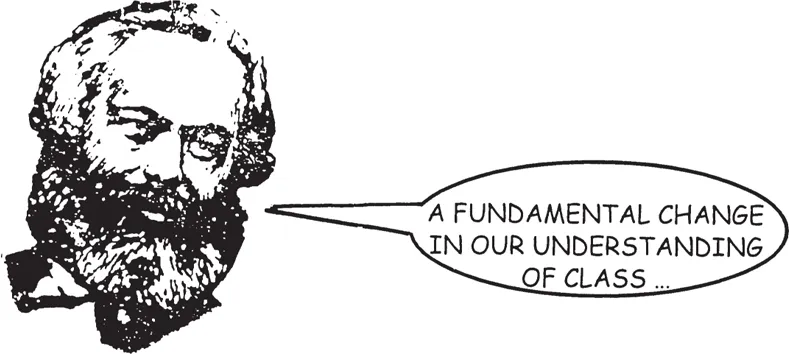
A FUNDAMENTAL CHANGE IN OUR UNDERSTANDING OF CLASS ...

TRANSGRESSION OF PREVIOUS SEXUAL PROTOCOLS AND RULES IN PERSONAL LIFE ...
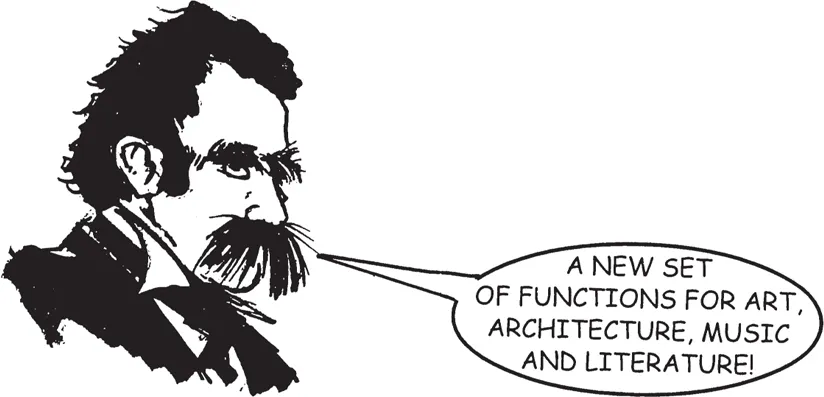
A NEW SET OF FUNCTIONS FOR ART, ARCHITECTURE, MUSIC AND LITERATURE!
So, modernism concerns not only novelty and difficulty, but also a change in social dynamics. Nevertheless, we are still in the realm of generalities. How do we identify the specifics of modernism? Perhaps the question of modernism’s timeliness is a good way to begin.
Chronologies and dates are often seen as the boring bits of cultural history. Stuff we glance at, or skip over, in our hurry to get to the “heart of the matter”. But with accounts of modernism, something strange happens. Dates and starting points begin to matter. The problem with defining modernism is that of fixing a chronology – who did what first, when and where? Establishing the credentials of originality is crucial to modernism.
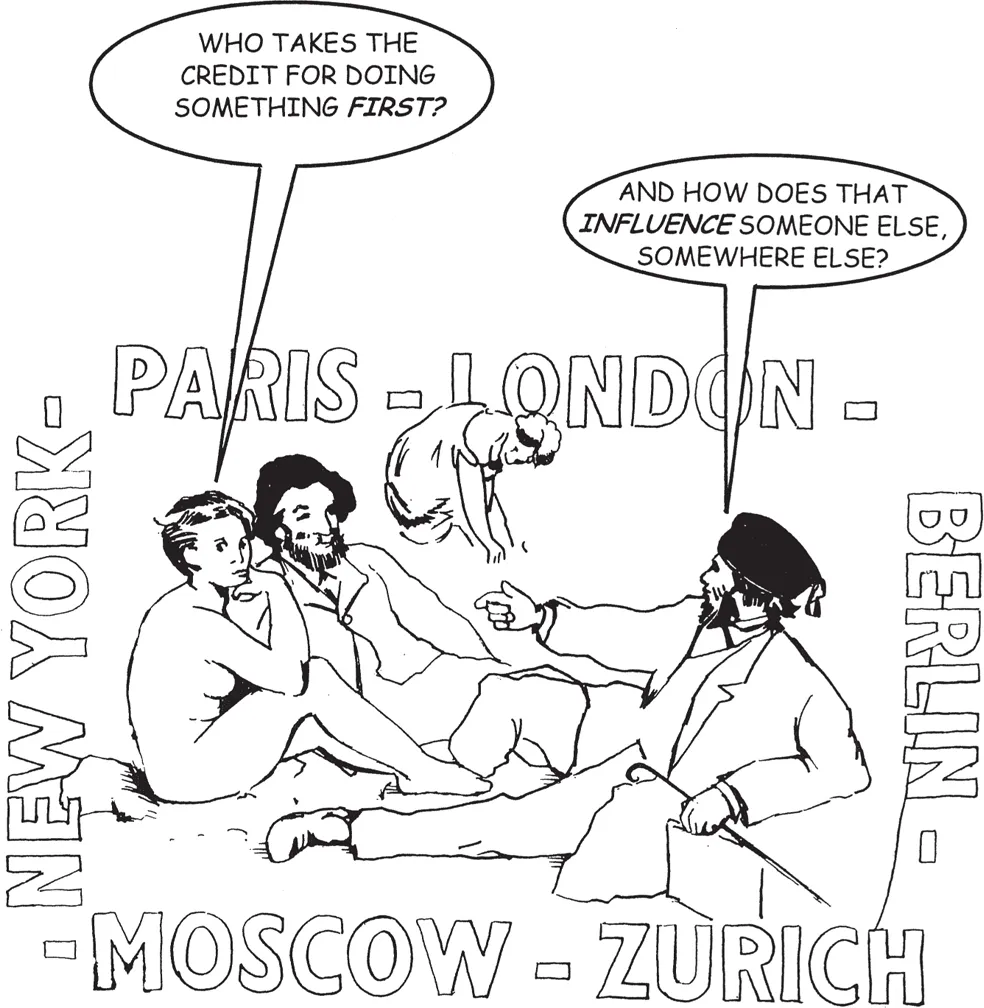
WHO TAKES THE CREDIT FOR DOING SOMETHING FIRST?
AND HOW DOES THAT INFLUENCE SOMEONE ELSE, SOMEWHERE ELSE?
AND HOW DOES THAT INFLUENCE SOMEONE ELSE, SOMEWHERE ELSE?
We can get lost in a complex schedule of “originalities” that pollinate each other across frontiers – but always from one major city to another: Paris, London, Berlin, Moscow, Zurich, New York …
Mode...